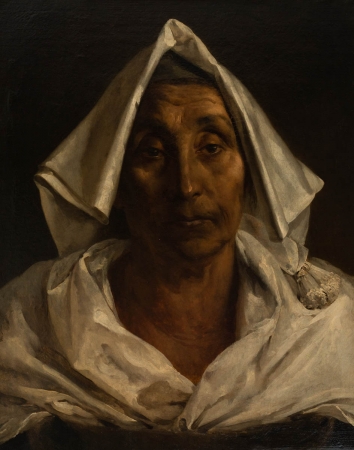Schnetz or Géricault, The Old Italian Woman

Jean-Victor SCHNETZ (1787-1870) ou Théodore GÉRICAULT (1791-1824)
The Old Italian Woman
oil on canvas
62.3 x 50 cm
© MuMa Le Havre / David Fogel
The Old Italian Woman
oil on canvas
62.3 x 50 cm
© MuMa Le Havre / David Fogel
HD image
This portrait of The Old Italian Woman, placed on deposit by the Louvre in the Le Havre museum in 1872, was part of the major La Caze bequest of 1869, and was attributed to Jean-Victor Schnetz (1787–1870) at the time. On loan to the Château de Flers museum in 2000 for a retrospective on the painter, the artwork was then, most spectacularly, reattributed to Théodore Géricault (1791–1824). Bruno Chenique and Sylvain Laveissière, who researched the comparison, found a series of convincing matches with confirmed paintings by the great master.
According to their analysis, the artwork has the characteristics of a Géricault in terms of framing and the rendering of skin and clothes. To support his hypothesis, Bruno Chenique made painstaking comparisons with the mane of the Head of a White Horse by Géricault, with the eyes of the Portrait of a Kleptomaniac and with the skin of the Severed Heads, strange still-life studies the artist used as documentary material for The Raft of the Medusa.
Nevertheless, not all experts agree on the attribution to Géricault, which remains the subject of passionate debate. The painting still holds secrets, and some points, such as its dating and its aim, remain to be clarified.
The subject of the painting suggests that the artwork was completed in Rome, where Théodore Géricault resided in 1816 and 1817. The model, an elderly woman, her skin leathered from the sun, is portrayed in several paintings by artists who stayed at the Villa Medici in the 1820s. Léon Cogniet shows her in a pose similar to that of Géricault, François-Joseph Navez places her in a Scene of Brigands as a fortune teller, and Jean-Victor Schnetz depicts her in the same way in two of his paintings, with The Fortune Teller, c. 1820, and A Gypsy Predicting the Future of Sixte-Quint, in 1826, of which he produced six different versions. The residents at the French Academy in Rome and the artists who revolved around the institution formed a tight circle. They did not hesitate to paint and explore the Roman countryside together, not to mention share the same models. This old Italian woman, who exemplified the peasant from southern Italy, thus lent her striking facial features to these young artists in search of original and unmistakable models. While some portrayed her in anecdotal scenes, the artist of this portrait captured her extraordinary presence with highly effective simplicity.
According to their analysis, the artwork has the characteristics of a Géricault in terms of framing and the rendering of skin and clothes. To support his hypothesis, Bruno Chenique made painstaking comparisons with the mane of the Head of a White Horse by Géricault, with the eyes of the Portrait of a Kleptomaniac and with the skin of the Severed Heads, strange still-life studies the artist used as documentary material for The Raft of the Medusa.
Nevertheless, not all experts agree on the attribution to Géricault, which remains the subject of passionate debate. The painting still holds secrets, and some points, such as its dating and its aim, remain to be clarified.
The subject of the painting suggests that the artwork was completed in Rome, where Théodore Géricault resided in 1816 and 1817. The model, an elderly woman, her skin leathered from the sun, is portrayed in several paintings by artists who stayed at the Villa Medici in the 1820s. Léon Cogniet shows her in a pose similar to that of Géricault, François-Joseph Navez places her in a Scene of Brigands as a fortune teller, and Jean-Victor Schnetz depicts her in the same way in two of his paintings, with The Fortune Teller, c. 1820, and A Gypsy Predicting the Future of Sixte-Quint, in 1826, of which he produced six different versions. The residents at the French Academy in Rome and the artists who revolved around the institution formed a tight circle. They did not hesitate to paint and explore the Roman countryside together, not to mention share the same models. This old Italian woman, who exemplified the peasant from southern Italy, thus lent her striking facial features to these young artists in search of original and unmistakable models. While some portrayed her in anecdotal scenes, the artist of this portrait captured her extraordinary presence with highly effective simplicity.






